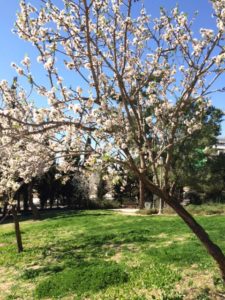Yesterday, I went out to buy a toy for my 3-month old baby girl. We perused the aisles of high tech games, life-like stuffed animals, and battery-operated battleships with lights and sounds and finally arrived at the 0-6 month baby toys. Not having had much experience with baby toys before (this is my first!), I was struck by the simplicity—mobiles with hanging colorful suns and moons, rattles, and textured teething rings. I picked out a plastic loop-like thing with rainbow animals and off we were.
Everything my daughter does and sees is a new experience. And this simple toy, something that could entertain a four-year-old for about 5 seconds (let’s not forget all the high tech toys us adults play with, too), opens up worlds for this little baby. Everything she does, touches, hears, sees or smells is new, big, and fresh.
That’s a baby’s world—ours looks much different.
More or less, we know what to expect. We go to the bank and wait in line. We open the fridge and there are last night’s leftovers. We work hard and (hope to) get a paycheck.
Yes, we adults have in many ways become used to the patterns of this world, but is our world really SO different from a baby’s? I’ve often wondered—how can we think of time (and life in general) in a way that is both continuous (builds on past) AND brand new?
Rabbi Natan of Breslov, an 18th century Jewish mystic and spiritual leader, teaches that time does not progress in an in exclusively linear fashion—that the past and the present repeats itself in the future but in a new form, and time is more of a spiral than a circle or a line. Think of a clock—every day, we experience “12 PM noon.” That 12 PM noon has some of the same qualities every day, but can also be extremely different from one day to the next.
So, one could consider time and renewal as both part of a repeating pattern AND something completely fresh and new.
In my life, I try (definitely not always succeeding) to look to my past experiences, repeat, and build upon what works, and then use those things to transform my future into something totally new, yet grounded.
This applies to my professional life as much as it does to my personal life. Often times, it is easy to get stuck in the moment—I have no business now! My client is unhappy with me! My co-worker and I are not getting along! (etc.). But if we can take our past successes with us as we encounter challenges, those challenges lose a bit of their bitterness.
Spring is coming! The almond trees are in full bloom, it’s a nice 75 degrees out, and there is a certain happy productiveness in the air. I look forward to a year of growth—physical (baby’s getting big!), spiritual, emotional, and professional. There’s something about the spring that always seems to bring that feeling of newness, that looking at where you have been and considering where to head next.
For me, being grounded in my past with the knowledge that renewal, rejuvenation, and plain and simple originality is always coming makes every day a little sweeter, and perhaps makes my world a little more like my baby’s.
Tell me, how do you incorporate your past experiences into your future plans? What do you see as the optimal balance between newness and repetition?

Margy Kerr-Jarrett enjoys reading, writing, and spending time in nature with her husband and daughter. Born and raised in Indianapolis, IN, Margy has been living in Jerusalem, Israel for the past three years.


The best gift we have beside life itself is the gift of memory. Through it we have relationships, learning, and ability to piece things together, to compare what is to what was, and both remember the past and use it to affect our future. Babies do all of that. They just don’t realize it. I loved this story. I’m looking forward to your next one already.
Thanks so much, Jane!
I love that perspective, Margy.